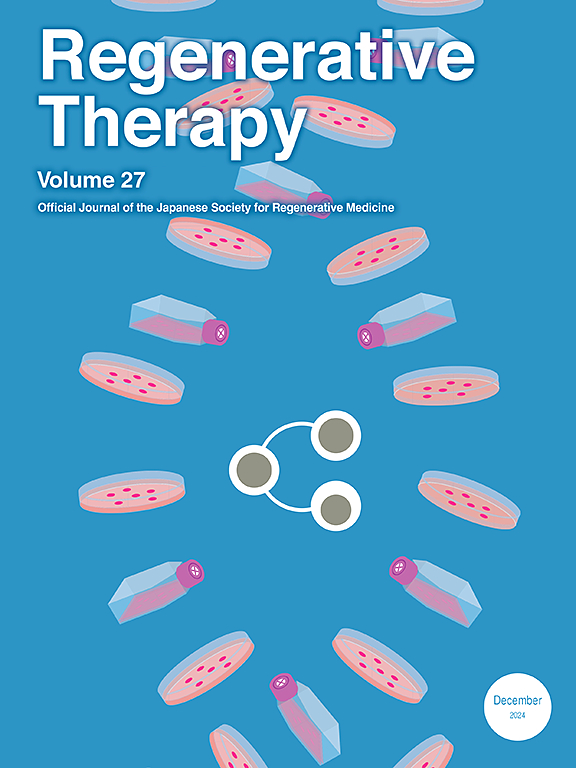3D脑再生支架的可打印生物材料:体内生物相容性评估
IF 3.5
3区 环境科学与生态学
Q3 CELL & TISSUE ENGINEERING
引用次数: 0
摘要
脑损伤后的再生是临床前开发中许多治疗策略所面临的挑战。人们对植入脑损伤部位的支架越来越感兴趣。3D打印的发展为设计适应组织解剖结构的不同组成的复杂结构提供了可能性。方法本可行性研究评估了四种生物可消除数字光处理(DLP)打印材料在大鼠模型中的脑生物相容性:甲基丙烯酸明胶(GelMA)、聚乙二醇二丙烯酸酯(PEGDA)与GelMA混合(PEGDA-GelMA)、聚碳酸三甲乙烯三甲丙烯酸酯(PTMC-tMA)和富马酸聚丙烯-b聚γ-甲基ε-己内酯-b-富马酸聚丙烯(P(PF-MCL-PF))的ABA三嵌段共聚物。将其耐受性与临床常用的神经外科缝合成分聚二氧环酮(PDSII)进行比较。一个月的核磁共振和行为随访有助于安全性评估。结果高分辨率T2 MRI成像可有效捕获支架结构,显示其在监测降解性方面的无创应用。PDSII作为可接受的炎症反应的控制植入式异物。GelMA, PEGDA-GelMA和PTMC-tMA不影响允许的胶质屏障,促进细胞迁移和新生血管,没有额外的病灶周围小胶质细胞炎症(中位平均值为6.5%,而PDSII对照组为8.2%)。然而,GelMA支架核心没有定植,并且允许有限的神经元祖细胞募集。PTMC-tMA的刚性促进了植入,但带来了组织学问题。大脑对P(PF-MCL-PF)几乎没有反应。结论这些材料可作为脑再生的基础材料。PEGDA-GelMA作为脑内植入的有希望的候选材料,结合了生物物理和生物打印的优势,同时与临床使用的缝合相比保持可接受的炎症水平,为创新疗法铺平了道路。本文章由计算机程序翻译,如有差异,请以英文原文为准。

Printable biomaterials for 3D brain regenerative scaffolds: An in vivo biocompatibility assessment
Background
Brain regeneration after injury is a challenge being tackled by numerous therapeutic strategies in pre-clinical development. There is growing interest in scaffolds implanted in brain lesions. Developments in 3D printing offer the possibility of designing complex structures of varying compositions adapted to tissue anatomy.
Methods
This feasibility study assessed the cerebral biocompatibility of four bioeliminable Digital Light Processing (DLP) printed materials in the rat model: gelatin methacrylate (GelMA), poly(ethylene glycol)diacrylate (PEGDA) mixed with GelMA (PEGDA-GelMA), poly(trimethylene carbonate) trimethacrylate (PTMC-tMA) and an ABA triblock copolymer of polypropylene fumarate-b-poly γ-methyl ε-caprolactone-b-polypropylene fumarate (P(PF-MCL-PF)). Their tolerance was compared to that of polydioxanone Ethicon (PDSII), a neurosurgery suture component commonly used in clinical practice. A one-month MRI and behavioral follow-up aided in safety assessment.
Results
High-resolution T2 MRI imaging effectively captured the scaffold structures and demonstrated its non-invasive utility in monitoring degradability. PDSII served as a control of the acceptable inflammatory response to implantable foreign bodies. GelMA, PEGDA-GelMA and PTMC-tMA did not affect the permissive glial barrier, promoted cell migration, and neovascularization without additional perilesional microglial inflammation (median mean of 6.5 %, compared to 8.2 % for the PDSII control). However, the GelMA scaffold core was not colonized and allowed a limited neuronal progenitors recruitment. The rigidity of PTMC-tMA facilitated insertion, but posed histological issues. The brain hardly reacted to the P(PF-MCL-PF).
Conclusion
All these materials can serve as a basis for brain regeneration. PEGDA-GelMA emerged as a promising candidate for intracerebral implantation, combining biophysical and bioprinting advantages while maintaining an acceptable level of inflammation compared with clinically used suture, paving the way for innovative therapies.
求助全文
通过发布文献求助,成功后即可免费获取论文全文。
去求助
来源期刊

Regenerative Therapy
Engineering-Biomedical Engineering
CiteScore
6.00
自引率
2.30%
发文量
106
审稿时长
49 days
期刊介绍:
Regenerative Therapy is the official peer-reviewed online journal of the Japanese Society for Regenerative Medicine.
Regenerative Therapy is a multidisciplinary journal that publishes original articles and reviews of basic research, clinical translation, industrial development, and regulatory issues focusing on stem cell biology, tissue engineering, and regenerative medicine.
 求助内容:
求助内容: 应助结果提醒方式:
应助结果提醒方式:


